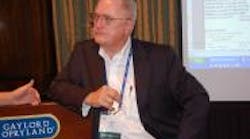“Our commitment [is] to generate positive results for our shareholders during these challenging economic times.” –Daniel C. Ustian, Navistar’s chairman, president and CEO
These are probably the worst of times to try and develop and deliver new truck products to the market, mired as we are in the midst of a calamitous economic recession and facing stiff surcharges for expensive emissions control technology in a scant four months.
Yet all the truck OEMs instinctively realize you just can’t sit still anymore, either; making only the bare minimum of investments in new truck designs for this marketplace. Even though all the pricey emission control systems heading for new trucks Jan. 1, 2010, are the result of federal mandates (Read as: the OEMs have no choice but to put them on their products), all the manufacturers took the opportunity to make design changes and upgrades to their products outside the emissions arena.
Most are also forging ahead down new product avenues, even though these expensive and time-consuming efforts sometimes don’t pan out. But building trucks is sometimes akin to playing baseball; you often don’t improve your hitting averages unless you step up to the plate and swing more frequently.
Navistar provides a good example of this strategy as it continues to try new endeavors despite some recent tough going.
For instance, the company just took the wraps off its new truck-making joint venture with erstwhile truck engine denizen Caterpillar Inc. – rolling out NC2 Global LLC to build a full line of commercial on-highway trucks for a wide range of global markets, while simultaneously designing a heavy-duty vocational truck for North America.
The 50/50 joint venture – hammered out in June last year – is focused initially on developing, manufacturing, and distributing commercial trucks in Australia, Brazil, China, Russia, South Africa, and Turkey. NC2’s product line will feature both conventional and cab-over truck designs and will be sold under both the Navistar’s "International" brand and well as Caterpillar’s "CAT" brand.
Both companies are also still aiming on rolling out a new proprietary, purpose-built, heavy-duty CAT vocational truck for the North American market by mid-2011; manufactured at Navistar’s Garland, Texas facility, yet sold and serviced through the CAT North American dealer network.
Navistar’s Al Saltiel (at left) is going to serve as president of NC2, with Bob Iacullo as the firm’s CFO. Saltiel has been a key player at Navistar since he joined the company in 2004, serving not just as vice president of marketing but responsible for all brand, product and pricing strategy. Iacullo is the former business resource manager for Caterpillar’s infrastructure product development division, so both Navistar and Caterpillar are going to have key executives at the helm of NC2.
This is a pretty bold effort, and it’s one both companies are betting on for long-term success. “The formation of this joint venture represents a long-term strategic decision,” noted Caterpillar Group President Doug Oberhelman (seen here at right), who will service as NC2’s chairman of the Board, with Navistar's Truck Group President Dee Kapur as lead director.
“Despite the current challenges facing the global economy, both Caterpillar and Navistar are dedicating the right people and investing significant resources to ensure NC2’s long-term success in the global on-highway truck market,” Oberhelman stressed.
Navistar in particular could use some long-term success after it lost a large-scale effort to win a big contract to build mine resistant armor protected (MRAP) vehicles for the U.S. military back in June to Oshkosh Corp. And it didn’t help matters when Navistar had to take a $30 million charge against earnings in its third fiscal quarter due to revised tax estimates, resulting in a $12 million net loss for the period on $2.51 billion in revenues. That’s compared to profits of $331 million on $3.95 billion in revenues in the third quarter of its last fiscal year.
“The third quarter is traditionally our most challenging quarter, but we remain focused on the long-term success of the company,” said Daniel C. Ustian, Navistar’s chairman, president and CEO in a statement. “Therefore, we elected not to implement drastic short-term cost cutting actions that would have impacted our ability to deliver long-term results.”
That being said, Ustian (at left) expects Navistar to be profitable by the end of its fiscal year, though not as profitable as previously projected. When the company’s fiscal year ends on Oct. 31, he said overall profits should range between $182 million and $207 million.
This comes despite Navistar’s belief that overall truck industry retail sales volume for Class 6-8 vehicles and school buses in the U.S. and Canada will remain sluggish, totaling between 165,000 and 185,000 units. The OEM added that the industry is anticipating only a minimal pre-buy in 2009 ahead of 2010 emissions requirements, with industry volumes will be in the range of 175,000 to 215,000 units next year.
It’s a tough road to travel this year for everyone in trucking, OEMs included. But as Navistar’s story illustrates, no one is slacking off in terms of future plans – and that should serve truckers of all stripes well in the years ahead.







